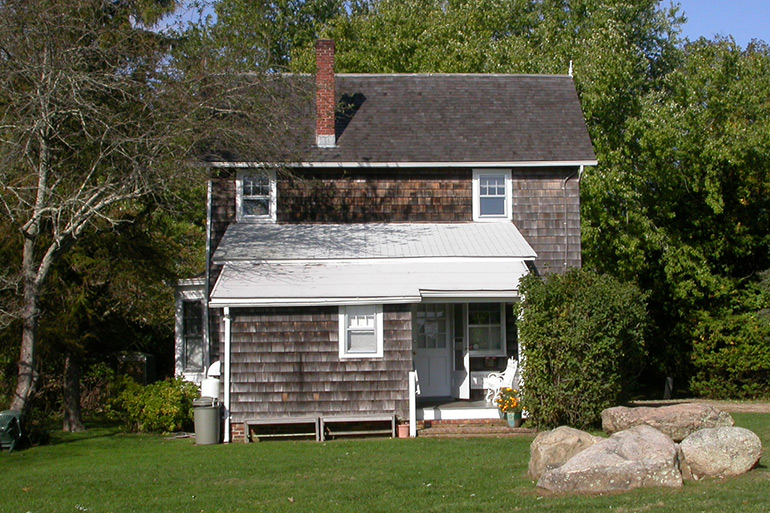Lemonade from Lemons: Pollock-Krasner House and Study Center Parking Solution

Since August 2, access to the popular Pollock-Krasner House and Study Center on Springs-Fireplace Road in Springs has been restricted to visitors by appointment only. It’s a parking problem. So many people flock to see this historic place, and because only three or four cars can be accommodated in the driveway, visitors have been parking up and down Springs-Fireplace Road, and it has to stop.
Jackson Pollock moved from Greenwich Village to East Hampton in 1945 and created his remarkable drip paintings at his house here for nearly the next 11 years until his death. You can see the concrete platform out on the grand back lawn where he stood on a ladder and splashed paint down onto huge canvasses. You can also walk through his home. It is restored to almost exactly the way it was in 1950, complete with the vacuum tube hi-fi system that poured bebop music out to him where he worked.
It is inspirational to be part of Pollock’s world, and this year, from when the house opened for the season in May, an average of 1,000 people a month have made the journey to this shrine. But because the visitors park their cars up and down the street, according to Town Attorney Michael Sendlenski, there are “significant concerns about the traffic congestion and safe parking conditions that result from the expanded use of the premises.”
After Pollock died, his wife, painter Lee Krasner, lived at the property for the next 30 years. It was she who thought the house should be kept on into the future as a study center for scholars and students of the art of Abstract Expressionism. In 1982, Town Supervisor Judy Hope asked me to head up a committee to see if East Hampton town could take it over as per Lee Krasner’s wishes.
I met with Ms. Krasner several times at the house. And after she died in 1984, our committee met monthly in their dining room around the big Pollock dining table to consider the matter further. We invited merchants, tourists, farmers, other artists and sculptors, fishermen and government officials to give their opinions. In the end, amidst all of this history, I filed a report proposing that the house be kept up exactly as it was when Pollock painted there, right down to the old-fashioned appliances, furniture, books, silverware and furniture.
The Town Supervisor and I traveled to New York City to meet with the lawyers for her estate and present our proposal. But in the end, the lawyers decided to go with a proposal submitted by Stony Brook University, separately from ours, but which, as it turned out, had come to the same conclusion that we had. There was magic here. A genius at work a generation earlier. In 1988, with the blessing of the Town, the house, run by Stony Brook, opened to visitors who made appointments in advance to tour the property.

Two years later, Helen Harrison, the director of the property, leading a group of people onto the Masonite squares that cover the floor of the detached studio where Jackson painted from 1945 until his death and his wife from then on, wondered what was under the Masonite. Removing them, she found the original paint-splattered wooden floor covered with the drippings of Jackson Pollock’s paint.
As a result, it was possible to now offer visitors a still more extraordinary experience. You could take off your shoes, put on soft cotton booties and walk briefly across his actual studio floor to feel what Jackson felt when he made his paintings there.
In 1994, the house was named a National Historic Landmark. And Director Harrison responded to the greater public demand to experience this place by opening it to the general public three afternoons a week. The parking problem ensued. This is a residential area. The street here is narrow.
Because of this increase in popularity, the annual income from the visitors—$5 and $10 admission—soared to about $100,000 a year. Now it is scaled back. People who show up Thursday to Sunday beyond a limit of 12 people on one of three tours between noon and 5 p.m. will be turned away.
But perhaps a solution can be found to have it stay available on a grand scale again without causing a parking problem. The same number of people as before could enjoy this experience. The relatively large amount of income, which funds programs at the house, could continue.
Keep the appointment-only rule. Eliminate the parking problem.
People wishing to come would either come out to the East Hampton railroad station by train or by car, parking in the public lot near the railroad station and walking to the train station. There’s free parking. And there is lots of it.
Get on the County 10B bus. It leaves from right in front of the railroad station.
It takes you on an unforgettable sightseeing trip through the town, passing the homes and studios of dozens of other Abstract Expressionist painters who lived here during that period when Springs was considered, around the globe, to be the center of Abstract Expressionist painting.
The bus operates, and has operated, for years, every day but Sunday, on a round trip from the railroad station at roughly two-hour intervals up through Springs and, after making stops along the way, back to the station. Busses leave the station at 6:50 a.m., 8 a.m., 9 a.m., 10:05 a.m., 11:15 a.m., 1:20 p.m., 3:30 p.m. and 5:45 p.m. They are 50-passenger busses.
Knowing the time of the bus you want to be on, you can make your reservation in advance at Pollock-Krasner to be there exactly 25 minutes after the bus leaves the station. It’s a published route. That’s all it takes. It stops at the house.
When finished at Pollock-Krasner, take a later 10B bus back to the station. (Pollock-Krasner is almost at the farthest point into Springs). Cost of the historic bus ride is just $2.25 each way, $1.25 for students and kids under 5 are free. There is no smoking, drinking or eating on the bus, and no playing radios loud. The county would be delighted to have the additional revenue from the visitors to Pollock-Krasner. It’s win-win.
What is quite interesting about the bus ride is that if you are traveling as a disabled person, you can arrange in advance to have an “attendant” come on the bus and accompany you for free.
I propose that this attendant take a short course about the history of Pollock-Krasner House. The railroad is where Pollock caught the train to New York City to visit his patron, art gallery owner Peggy Guggenheim. At this station—which as it happens is now being fully restored to its 1905 splendor—he also met his mistress when she came out while his wife was away.
Most interesting, perhaps, is that on your trip on the 10B bus back to the station, the bus passes the exact turn on Springs-Fireplace Road at the corner of Abrahams Path where Pollock, in 1956, swerved his new Oldsmobile convertible off the road while drunk, killing both himself and Edith Metzger, one of his two female companions. He was 44. They were in their early 20s.
The attendant would point it out. And then a short time later you’d be back at the station and either to your car or to the station platform for a train trip home. Problem solved.



